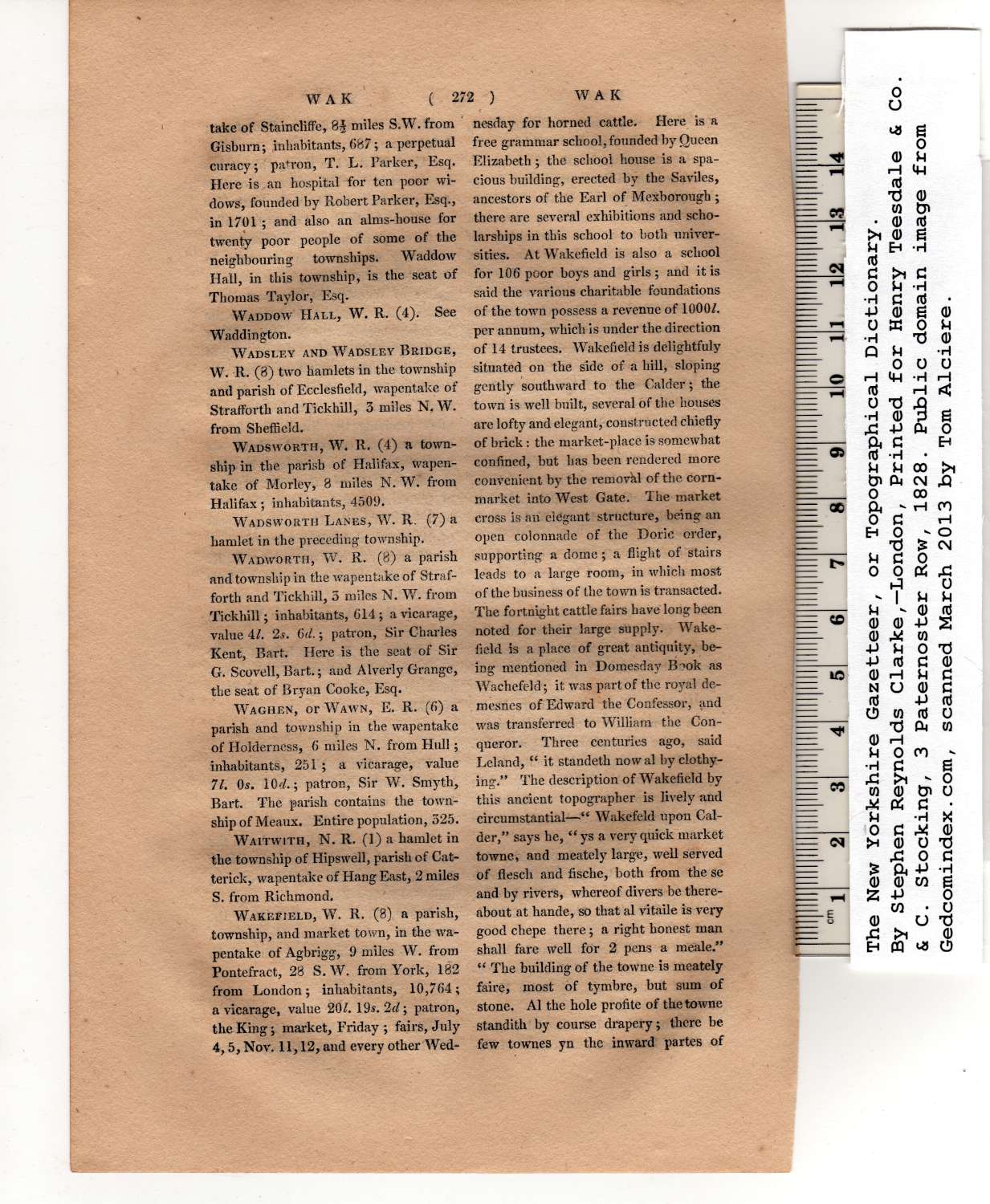|
take of Staincliffe, 8§ miles S.W. from
Gisburn; inhabitants, 687; a perpetual
curacy; patron, T. L. Parker, Esq.
Here is an hospital for ten poor wi-
dows, founded by Robert Parker, Esq,,
in 1701 ; and also an alms-house for
twenty poor people of some of the
neighbouring townships. Waddow
Hall, in this township, is the seat of
Thomas Taylor, Esq.
Waddow Hall, W. R. (4). See
Waddington.
Wadsley and Wadsley Bridge,
W. R. (8) two hamlets in the township
and parish of Ecclesfield, wapentake of
Strafforth and Tickhill, 3 miles N. W.
from Sheffield.
Wadsworth, W. R. (4) a town-
ship in the parish of Halifax, wapen-
take of Morley, 8 miles N. W. from
Halifax; inhabitants, 4509.
Wadsworth Lanes, W. R. (7) a
hamlet in the preceding township.
Wadworth, W. R. (8) a parish
and township in the wapentake of Straf-
forth and Tickhill, 3 miles N. W. from
Tickhill; inhabitants, 614; a vicarage,
value 4/. 2s. 6d.; patron, Sir Charles
Kent, Bart. Here is the seat of Sir
G. Scovell, Bart.; and Alverly Grange,
the seat of Bryan Cooke, Esq.
Waghen, or Wawn, E. R. (6) a
parish and township in the wapentake
of Holderness, 6 miles N. from Hull;
inhabitants, 251 ; a vicarage, value
7/. 0j. 10«?.; patron, Sir W. Smyth,
Bart. The parish contains the town-
ship of Meaux. Entire population, 325.
Waitwith, N. R. (1) a hamlet in
the township of Hipswell, parish of Cat-
terick, wapentake of Hang East, 2 miles
S. from Richmond. |
Wakefield, W. R. (8) a parish,
township, and market town, in the wa-
pentake of Agbrigg, 9 miles W. from
Pontefract, 28 S. W. from York, 182
from London; inhabitants, 10,764;
a vicarage, value 20/. 195.2a?; patron,
the King; market, Friday ; fairs, July
4,5, Nov. 11,12, and every other Wed-
nesday for horned cattle. Here is a
free grammar school, founded by Queen
Elizabeth; the school house is a spa-
cious building, erected by the Saviles,
ancestors of the Earl of Mexborough ;
there are several exhibitions and scho-
larships in this school to both univer-
sities. At Wakefield is also a school
for 106 poor boys and girls; and it is
said the various charitable foundations
of the town possess a revenue of 1000/.
per annum, which is under the direction
of 14 trustees. Wakefield is delightfuly
situated on the side of a hill, sloping
gently southward to the Calder; the
town is well built, several of the houses
are lofty and elegant, constructed chiefly
of brick: the market-place is somewhat
confined, but has been rendered more
convenient by the removhl of the corn-
market into West Gate. The market
cross is an elegant structure, being an
open colonnade of the Doric order,
supporting a dome; a flight of stairs
leads to a large room, in which most
of the business of the town is transacted.
The fortnight cattle fairs have long been
noted for their large supply. Wake-
field is a place of great antiquity, be-
ing mentioned in Domesday Book as
Wachefeld; it was part of the royal de-
mesnes of Edward the Confessor, and
was transferred to William the Con-
queror. Three centuries ago, said
Leland, <c it standeth now al by clothy-
ing.” The description of Wakefield by
this ancient topographer is lively and
circumstantial—“ Wakefeld upon Cal-
der,” says he, “ ys a very quick market
towne, and meately large, well served
of flesch and fische, both from the se
and by rivers, whereof divers be there-
about at hande, so that al vitaile is very
good chepe there; a right honest man
shall fare well for 2 pens a meale.”
“ The building of the towne is meately
faire, most of tymbre, but sum of
stone. Al the hole profite of the towne
standith by course drapery; there be
few townes yn the inward partes of |
